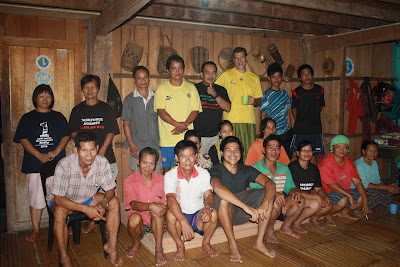 |
| Crossing the Papar River |
In the spirit of supporting Sabah’s transition into community-based renewables, Daniel joined TONIBUNG, Green Empowerment and LEAP representatives in a trek through the Crocker Range rainforest. The destinations were the micro-hydro powered villages of Terian and Buayan. The micro-hydro power systems (5 KW and 10KW respectively), are owned, managed and maintained by the people of Terian and Buayan, and supported by community organizations PACOS Trust and TONIBUNG (Friends of Village Development).
 | ||||
| Daniel, Adrian Lasimbang of TONIBUNG and Gabriel Wynn of Green Empowerment at Irene Tani's house with the people of Kampung Buayan after community consultations |
 |
| Daniel, Johan of Kampung Terian and Ginus, micro-hydro operator of Kampung Buayan with Buayan's Micro Hydro Turbine |
Daniel and the team were quick to highlight the importance of Buayan continuing to take the lead in developing their community using renewable resources, and more importantly, to share their ideas and experiences with other communities. They also stressed that the story of Buayan- both in terms of their struggle in opposing the Kaiduan dam, and in terms of their ability to take their village’s sustainable development into their own hands- needed to be told. The SEAREPA will be one space where the voices of Buayan, and others like them throughout Southeast Asia, will be heard.
 |
| Making the last crossing home on the Papar River |
No comments:
Post a Comment